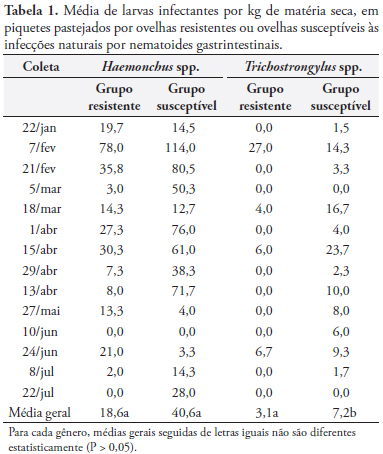The degree of contamination of herbage with third stage larvae of gastrointestinal nematodes was evaluated in paddocks grazed by resistant or susceptible ewes. The trial occurred from November 23, 2007 to July 22, 2008. Initially, fecal egg counts (FEC) were performed with individual samples of 130 adult ewes of the Bergamacia breed. Of those animals, nine ewes with the highest FEC (susceptible group) and 10 with the lowest counts (resistant group) were selected and moved to separate paddocks. The resistant ewes presented lower FEC, higher values of packed cell volume, total plasma protein and blood eosinophils than the susceptible ewes. The weight was also higher in the resistant group. Haemonchus spp., Trichostrongylus spp. and Oesophagostomum spp. third stage larvae were recovered from pasture. In average, the amount of Haemonchus spp. and Trichostrongylus spp. third stage larvae in the pasture were 2.19 and 2.31 times, respectively, higher in the paddocks grazed by susceptible group in comparison with those grazed by the resistant animals. Therefore, the susceptible animals should be eliminated from the flock in order to reduce pasture contamination and optimize the prophylaxis of gastrointestinal nematode infections.
Haemonchus; Trichostrongylus; pasture; sheep; prophylaxis




